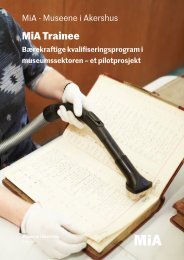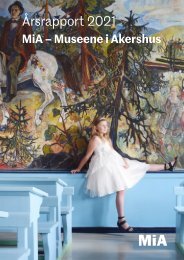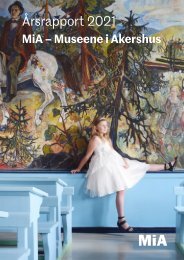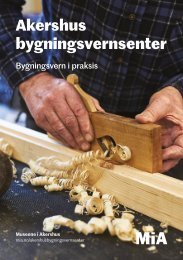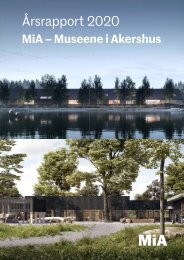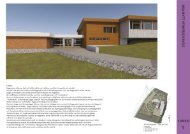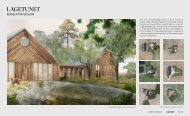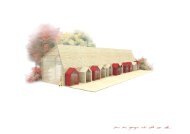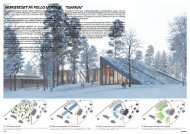European peonies
Create successful ePaper yourself
Turn your PDF publications into a flip-book with our unique Google optimized e-Paper software.
MiA - Museums in Akershus<br />
<strong>European</strong> <strong>peonies</strong> in<br />
Norwegian clone archives<br />
– a morphological study<br />
Mari Marstein, curator NMF<br />
Museums in Akershus<br />
mia.no
Text and photos:<br />
Mari Marstein, curator NMF, MiA - Museums in Akershus<br />
© Museums in Akershus, 2020
Background<br />
The Finnish Gene Resources Centre Luke<br />
initiated in 2018 an investigation of <strong>European</strong><br />
and West-Asian <strong>peonies</strong> in Nordic clone archives.<br />
The investigation covered morphological studies<br />
and DNA-studies of Paeonia anomala, Paeonia<br />
x hybrida, Paeonia humilis flore pleno, Paeonia<br />
tenuifolia and Paeonia x festiva.<br />
I received support from the Norwegian<br />
Directorate of Agriculture to make a<br />
morphological study of these <strong>peonies</strong> in<br />
Norwegian clone archives. Samples were sent<br />
to Finland for DNA-studies. These results are not<br />
present as this article is published. All plants are<br />
collected in gardens. Paeonia humilis flore pleno<br />
has now got the formal name Paeonia ‘Nordic<br />
Paradox’, and this name will be used in this study.<br />
The original aim with my part of the investigation<br />
was:<br />
··<br />
To find out which of these <strong>peonies</strong> grew in<br />
Norwegian clone archives.<br />
··<br />
To make a checklist of characters for each<br />
taxon.<br />
It proved to be harder than originally supposed<br />
to identify the <strong>peonies</strong>, especially in the P. x<br />
hybrida- and P. tenuifolia-group. After working<br />
through the collected material I added a third<br />
point:<br />
··<br />
To find useful names for the collected<br />
plants.<br />
After the initial chapters I will describe a<br />
selection of collected plants. These will be<br />
compared to descriptions of the species, and<br />
similarities and differences will be discussed,<br />
before conclusion of what name I will<br />
recommend for each one of them.<br />
Illustration<br />
Peonies at Gamle Hvam museum. At rear the pink<br />
Paeonia anaomala. In front from left: Paeonia x festiva<br />
‘Rubra Plena’, Paeonia ‘Nordic Paradox’ and Paeonia x<br />
festiva ‘Rosea Plena’.<br />
3
Problems in<br />
identifying <strong>peonies</strong><br />
Terms<br />
The taxonomy of the genus Paeonia is confusing.<br />
Several species hybridize and new forms arise,<br />
without any knowledge of what parents are<br />
involved. Further there are many intermediate<br />
forms, even within the species. (Passalacqua<br />
& Bernardo 2004:216, Cullen et al. 2011:445).<br />
Peonies seem to be influenced by the conditions<br />
under which they grow, the so called phenology.<br />
Temperature, amount of daylight, humidity and<br />
latitude influence the plants to a degree that one<br />
might think they are different species. Further, it<br />
is a problem that two different plants can have<br />
the same description, without being identical.<br />
To identify <strong>peonies</strong>, many characters have<br />
to be compared. This survey is about plants<br />
growing in culture, and for them there are not<br />
as comprehensive descriptions as for plants<br />
growing in the wild.<br />
The identification is based on literature that<br />
in my opinion is reliable and thorough. Hong<br />
De-Yuan’s two books: Peonies of the world:<br />
Taxonomy and phytogeography (2010) and<br />
Peonies of the world: Polymorphism and<br />
diversity (2011) is based on extensive field<br />
observations around the world, in all regions<br />
where <strong>peonies</strong> grow naturally. Hong gives<br />
detailed descriptions that can be compared to<br />
my own morphological observations.<br />
I use two older monographs concerning <strong>peonies</strong><br />
grown in culture: A monograph of the genus<br />
Paeonia (Anderson 1819) and A study of the<br />
genus Paeonia (Stern 1946). The <strong>European</strong><br />
Garden flora (Cullen et al. 2011) gives good<br />
descriptions as well. These give a survey of<br />
the peony systematics for the last 200 years,<br />
but since this is a difficult genus, the different<br />
authors do not always agree.<br />
By Europaean <strong>peonies</strong> I mean species and<br />
crossings where these are included, with natural<br />
habitats in Europe and in the western parts of<br />
Asia.<br />
A clone is a plant that is separated from the<br />
original plant by root parts. The old and the<br />
new plants are identical, sharing the same<br />
characteristics.<br />
A clone archive is a collection of clones growing<br />
in soil and tended, such as in a garden.<br />
Some crossings have a unique cultivar name,<br />
written in simple quotes, like Paeonia x festiva<br />
‘Rubra Plena’ or Paeonia ‘Nordic Paradox’.<br />
Morphology is the science of form, size and<br />
structure. By comparing the plants forms to each<br />
other and to published descriptions, we might<br />
trace the botanical relationships.<br />
Phenology is about how the climate influence a<br />
plant’s growth, size, colour and periodical cycle.<br />
This survey includes plants from south to north<br />
in Norway, and from coast to inland, and it is<br />
interesting to observe the differences between<br />
the regions.<br />
Taxonomy is classification of plants into the<br />
correct group, either family, genus or species.<br />
4
Sources<br />
Method<br />
The most important sources are the plants<br />
themselves, with information of where they are<br />
collected and their history. The study of living<br />
plants is essential for species determination.<br />
Photos and written descriptions are not enough.<br />
The senses perceive details that cannot be<br />
conveyed in text.<br />
Still written sources are necessary. Nursery<br />
catalogues from 1900–1950 tells us which<br />
nurseries sold the different species or cultivars.<br />
However, the name in the plant list may not<br />
always be the correct name of the plant. I will<br />
return to this under the discussion of Paeonia x<br />
hybrida.<br />
Facebook should not be neglected as a useful<br />
source. In many groups there is considerable<br />
experience and knowledge, and discussions<br />
in groups like “The Swedish Peony Society”<br />
have been useful. However, one must utilize<br />
considerable source criticism.<br />
The investigated plants grow in four Norwegian<br />
clone archives:<br />
··<br />
Agder nature museum and botanical garden<br />
in Kristiansand, Agder<br />
··<br />
Gamle Hvam museum’s plant collection in<br />
Nes, Akershus<br />
··<br />
Gamlehagen at Ringve botanical garden in<br />
Trondheim, Trøndelag<br />
··<br />
Tradisjonshagen at Tromsø arctic-alpine<br />
botanical garden, Troms.<br />
The method included the following actions:<br />
··<br />
to photograph the plant growing in the<br />
collection<br />
··<br />
to give a morphological description of a<br />
selection of the plants<br />
··<br />
to press plants for further investigations<br />
··<br />
to send samples to Finland for DNA-studies<br />
··<br />
to compare the collected plants to<br />
descriptions of the true species<br />
··<br />
to compare the collected plants to each<br />
other<br />
Mostly one or two stems were collected from<br />
each plant. In case of several specimens of the<br />
same species or cultivar, the best established and<br />
strongest was chosen. Weak plants were omitted.<br />
The following plants are described, photographed and pressed for herbarium specimens:<br />
Agder Gamle Hvam Ringve Tromsø<br />
Officinalis group GH 2006 23<br />
GH 2014 06<br />
Rubra/Rosea<br />
Plena group<br />
2001 1028<br />
2003 0248<br />
2006 0135<br />
GH 2007 17<br />
GH 2008 05<br />
GH 2008 09<br />
2004 501<br />
2008 224<br />
2004 207<br />
2010 153 1<br />
2010 153 2<br />
2010 70<br />
Anomala/intermedia/<br />
tenuifolia group<br />
GH 2009 09<br />
GH 2009 10<br />
1978 448<br />
2004 488<br />
2004 120<br />
‘Nordic Paradox’ GH 1980 01 2005 254<br />
5
Characters and<br />
descriptors<br />
The following describes how terms for<br />
characters are used in this article. The<br />
explanations are based on Hong (2010), Halda<br />
(2004), Judd et al. (1995) and Wikipedia.<br />
Roots are always thickened. Either tapering<br />
towards one end like a carrot or tapering<br />
towards both ends like a spindle (Hong 2010:29).<br />
Within our group of <strong>peonies</strong>, the only species<br />
with carrot-shaped roots is Paeonia anomala<br />
iIllustration in Hong 2010:128). All the other<br />
species relevant to this study have spindleshaped<br />
roots, which are more or less thickened.<br />
The roots I have dug up show great variation,<br />
and sometimes it is difficult to separate carrotshaped<br />
from spindle-shaped roots. I will only<br />
mention the roots in a few cases.<br />
Leaflets: All leaves are compound. Instead of<br />
using the terms biternate and triternate, I count<br />
leaf segments. It is a simpler and equally reliable<br />
method for identification. If a segment is only a<br />
few mm long, it is left out and not counted.<br />
According to Hong (2010:33f) the number of<br />
leaf segments in the lower leaves are valuable<br />
characters in determining species, as well as<br />
the leaflet width. Mostly I have pressed the<br />
lowermost, the middle and the top leaves of the<br />
stem.<br />
Leaf upper surface is mostly glabrous, without<br />
hairs. Some species have short, stiff hairs;<br />
bristles, along the veins on the upper surface.<br />
Illustrations (from top):<br />
Roots of Paeonia ‘Nordic Paradox’ from Gamle Hvam,<br />
Akershus. It is difficult to tell spindle-shaped from<br />
carrot-shaped roots.<br />
The lower leaf of GH 2009 09 Paeonia x hybrida<br />
Sørumsand, Akershus. Ca. 135 segments.<br />
Bristles along veins at Ringve 2004-501 Paeonia x<br />
festiva ‘Rosea Plena’.<br />
6
In some species the leaf upper surface looks as if<br />
it is covered in a thin wax coat. The term for this<br />
is glaucous. Raindrops will form pearls on this<br />
surface.<br />
Hair covering: Sepals, carpels and the lower<br />
leaf surface sometimes have more or less hair<br />
covering; indumentum. The different forms<br />
have different terms, but since I have not found<br />
unambiguously definitions and illustrations of<br />
these terms, I will describe them in my own<br />
words where necessary.<br />
The flower is single or double. Single flowers in<br />
this study have 12 petals or less, and they always<br />
have stamens and carpels. Double flowers in this<br />
study have up to 300 petals, and they never have<br />
stamens, since in the double flower the stamens<br />
are transformed into petal-like structures.<br />
Disk: The flower rests on a structure called<br />
disk or disc. It is like a plate, with a raised<br />
structure surrounding the carpels. The disk vary<br />
in height with ca. 3 mm as a maximum. The<br />
structure surrounding the carpels is more or less<br />
prominent, and the colour is white or reddish.<br />
This might be a determining character, but<br />
further comparison is needed.<br />
Illustrations (from top):<br />
Glaucous surface with raindrop on GH 1980 01<br />
Paeonia ‘Nordic Paradox’.<br />
Sepals with hispidulous hair covering, Agder 2006-<br />
0135 Paeonia x festiva ‘Rubra Plena’. Hispidulous<br />
describes short, stiff hairs, like a two days old beard.<br />
The disk in GH 2009 10 Paeonia anomala from<br />
Ringerike is rather flat, and the raised edge is white<br />
and not very prominent. The disk in GH 2014 06<br />
Paeonia officinalis Nes Hedmark is thick and wavy, and<br />
the raised edge is red and prominent.<br />
7
Bracts and sepals: According to Hong, the<br />
shape of bracts and sepals is a good defining<br />
character (2010:39ff). He defines a sepal as<br />
an element whose lower part is wider than the<br />
upper part, otherwise he defines it as a bract.<br />
He includes drawings of bracts-sepals series in<br />
his descriptions of all the species. I have made<br />
drawings for most of the plants I discuss.<br />
Illustration<br />
Bracts and sepals in Gamle Hvam 2008 05 Paeonia<br />
officinalis fra Gjerdrum, Akershus.<br />
8
Analysis and discussion of<br />
the collected specimens<br />
Paeonia anomala<br />
This might be the only true species in the<br />
whole study. It is collected from a farm in Ask,<br />
Ringerike, where it was well established in the<br />
1950s. The stems are upright and the plant<br />
needs no support during flowering time in the<br />
end of May. It fits Hong’s description of Paeonia<br />
anomala with one exception: According to Hong,<br />
the leaves should have 70-100 segments.<br />
In the pressed leaves of this plant there are 40 and<br />
60 segments. The leaflets size, however, matches<br />
Hong’s description, with a width of 0,8-3,2 cm.<br />
Study with lens suggests there are tiny bristles<br />
along veins, a character emphasized by Hong<br />
(2010:125). The foliage is lush, with 8-10 leaves<br />
on each stem, which is a rather high number<br />
compared to the other plants in this study.<br />
The flower is like an open bowl, with petals<br />
bending slightly outwards when the flower is<br />
mature. The colour is dark pink when it opens,<br />
but as the petals are thin, the colour looks<br />
paler when the light comes through. Flower<br />
diameter is 10-12 cm, and flower height is 5 cm.<br />
It is nodding outwards. Hong does not mention<br />
the flower diameter, but he states the number<br />
of petals to 6-9. Our plant has 7-8 petals. The<br />
filaments are white, and the stigmas are the<br />
same colour as the petals.<br />
Illustration<br />
Herbarium sheet for GH 2009 10 Paeonia anomala<br />
from Ask, Ringerike.<br />
9
Illustrations (from top)<br />
Flower, GH 2009 10 Paeonia anomala from Ask, Ringerike.<br />
Flower, GH 2009 10 Paeonia anomala from Ask, Ringerike, from side.<br />
10
The carpels are shiny and glabrous, usually five,<br />
sometimes four in each flower. They are upright<br />
during flowering, but fold flat outwards when ripe.<br />
According to Hong they are mostly hairy, rarely<br />
glabrous (2010:125), but both Anderson (1818:261)<br />
and Stern (1946:112) describes the carpels<br />
as glabrous in this species. Stern separates a<br />
variety with hairy (tomentose) carpels as Paeonia<br />
anomala var. intermedia. Hong (2010:205) does<br />
not accept this name as a valid taxon.<br />
Illustrations (from top):<br />
Carpels, GH 2009 10 Paeonia anomala from Ask,<br />
Ringerike.<br />
GH 2009 10 in a private garden.<br />
The sepals are caudate, which means they have<br />
a pointed tale on top. They are hispidulous only<br />
on the adaxial surface, near the top. This is an<br />
unusual character in our collection of <strong>peonies</strong>.<br />
The involucrate bracts are long and elegant, as<br />
in the drawing in Hong’s book (2010:128). All<br />
characters, except the number of leaf segments,<br />
correspond with Hong’s description of Paeonia<br />
anomala subspecies anomala. I have not found<br />
the subspecies vetchii among the Norwegian<br />
<strong>peonies</strong> collected from gardens.<br />
Photo of the plant in Hong (2011:40) gives the<br />
same general impression as Gamle Hvam’s plant,<br />
with the lush, but airy foliage and the nodding<br />
flowers. Gamle Hvam’s plant corresponds as<br />
a whole with Hong’s description of Paeonia<br />
anomala. The deviation in segments and<br />
indumentum lies within the accepted variation.<br />
I call Gamle Hvam’s plant, GH 2009 10 from<br />
Ask, Ringerike by the species name Paeonia<br />
anomala. I have not yet found it in many gardens<br />
in Norway, but a very similar plant was observed<br />
in a garden in Bismo, Skjåk, Oppland (Marstein<br />
and Vange 2009:10). The garden owner received<br />
it from a neighbour when they lived in Valdres,<br />
Oppland, in the 1980s. They brought the plant<br />
with them to Bismo when they moved here.<br />
Paeonia anomala’s natural habitat stretches<br />
through Siberia to the eastern end of the Kola<br />
peninsula, so this plant should easily grow well in<br />
most of Norway, Sweden and Finland. I suggest<br />
the Norwegian name sibirpion for this plant, as it<br />
corresponds with the Swedish name.<br />
11
Paeonia x smouthii<br />
This plant is supposed to be a crossing between<br />
Paeonia tenuifolia and Paeonia lactiflora. It is<br />
difficult to find a good description of it, but in the<br />
<strong>European</strong> Garden Flora (Cullen et al. 2011:450) it<br />
is described as follows:<br />
Stem hairless, 50-55 cm. Leaves 5-7. Lower<br />
leaves twice divided into 3, the divisions<br />
deeply cut into 15-18 very narrowly elliptic<br />
acute segments, 3-10 mm wide, hairless<br />
except for minute bristles along veins above.<br />
Flowers 1 or 2, bowl-shaped, 6-8 cm across,<br />
petals red, ca. 5 cm. Filaments yellow.<br />
Carpels 2-4, mostly 3, dark purple, hairless or<br />
slightly hairy.<br />
Ringve botanical garden keeps a plant that fits<br />
this description. Ringve 2004-488 is collected<br />
from Hylla, Inderøy, with a history that goes back<br />
to before 1960, when a young woman married<br />
into to the farm. The plant grew in the garden<br />
was from her mother-in-law.<br />
This plant was originally recorded at Ringve<br />
as P. anomala or P. x hybrida, but gardener<br />
Stefan Patrick Nilsen suggested it might be P.<br />
x smouthii. I agree with him. The sweet scent<br />
reveals the relationship to Paeonia lactiflora.<br />
The website Dave’s Garden, which I consider<br />
as a serious source, shows pictures that fits the<br />
plant at Ringve 11 . Louis van Houtte (1810–1876) is<br />
referred to as the breeder, with 1845 as the year<br />
of introduction. He plant originated probably<br />
from van Houtte’s nursery in Gentbrugge, which<br />
he owned together with Adolf Papeleu.<br />
The sweet scent, the deep purple carpels and<br />
the bowl-shaped flowers makes this plant easy<br />
to identify. So far I have no suggestion for a<br />
Norwegian name for this cultivar.<br />
Paeonia x hybrida or Paeonia tenuifolia?<br />
1 https://davesgarden.com/guides/pf/go/90366/<br />
Illustration<br />
Herbarium specimen of Paeonia x smouthii, Ringve<br />
2004-488, from Hylla, Inderøy i Trøndelag.<br />
12
Illustrations (from top)<br />
Ringve 2004-488 Paeonia x smouthii flowering in Ringve botanical garden, Trondheim.<br />
Dark purple carpels and yellow filaments. Ringve 2004-488 Paeonia x smouthii, from Hylla, Inderøy, Trøndelag.<br />
13
Illustration<br />
Bowl-shaped flower, 6-8 cm diameter. Ringve 2004-488 Paeonia x smouthii, from Hylla, Inderøy, Trøndelag.<br />
14
Paeonia x hybrida or Paeonia<br />
tenuifolia?<br />
In Finnish, Swedish, and Norwegian gardens<br />
grows a plant called Paeonia x hybrida, with<br />
the Swedish name herrgårdspion (manor house<br />
peony). This is supposed to be a distinctive<br />
horticultural form and an old hybrid in the Nordic<br />
countries 2 .<br />
According to Hong, Paeonia x hybrida is not a<br />
valid taxon. He includes all similar plants with<br />
leaflets up to 8 mm wide into the taxon Paeonia<br />
tenuifola, since he has observed such variation in<br />
natural populations.<br />
The <strong>European</strong> Garden Flora (Cullen et al.<br />
2011:450) describes Paeonia x hybrida (Pallas) like<br />
this:<br />
Stem to 60 cm. Flowers 9-10 cm across;<br />
petals deep red. Filaments reddish. Carpels<br />
2-4, densely felted hairy. H3. Late spring to<br />
early summer.<br />
that “P. laciniata is like P. tenuifolia but taller<br />
and the segments are broader – a mere variety.”<br />
Knowing that P. x smouthii has been called P.<br />
laciniata by some authors, this illustrates<br />
the confusion concerning these similar looking<br />
plants. The written descriptions coincide, but<br />
the plants look different. Hopefully the DNAstudy<br />
can bring some answers concerning the<br />
complex including Paeonia x hybrida, Paeonia<br />
x smouthii, Paeonia anomala and Paeonia<br />
tenuifolia.<br />
Oskarsson (2008:103) describes P. x hybrida as<br />
90-100 cm tall, early-flowering, with one flower<br />
to each stem. The plants rarely get ripe seeds, as<br />
only a small part of the pollen is fertile.<br />
Illustration<br />
P. x hybrida GH 2009-09 Sørumsand.<br />
This hybrid first arose before 1788 in the St<br />
Petersburg Botanic Garden and before 1935<br />
in the Hortus Bergianus, Stockholm, in both<br />
gardens when P. tenuifolia and P. anomala<br />
were growing together, and it has also been<br />
made by deliberate crossing in USA. It is almost<br />
indistinguishable from wild P. anomala var.<br />
intermedia except for defective pollen and the<br />
innermost sepal rounded and not mucronate.<br />
Stern (1946:111) says this about Paeonia x hybrida:<br />
P. hybrida of Pallas is said by A. P. de Candolle<br />
(1818) to be a garden hybrid between P.<br />
anomala and P. tenuifolia, but he adds that it<br />
“appears spontaneously in Tauria” and again<br />
2 E-mail from Martin Hajman 07.02.2019.<br />
15
Three of the <strong>peonies</strong> in this survey are close to<br />
the description of P. x hybrida. GH 2009 09<br />
from Sørumsand, Akershus has a history back<br />
to before 1960, when it grew in the garden of a<br />
small cabin just outside Oslo. In the first half of<br />
the 20th century, people from Oslo who could<br />
afford it, built these cabins, surrounded by a<br />
small garden, just outside the city border. As<br />
they were close to a train station or bus stop,<br />
they could easily be reached by public transport.<br />
In this way people living in the city centre could<br />
get into the countryside during weekends and<br />
holidays.<br />
Ringve 1978-448 comes from Svinvik’s<br />
arboretum in Møre, where Halvor and Anne<br />
Svinvik in the 1940s established their exotic<br />
garden, with rhododendrons, bamboos and other<br />
tender plants from around the world.<br />
Tromsø 2004-120 comes from a garden in<br />
Hamarøy, Nordland, where it was collected by<br />
botanist Brynhild Mørkved in 2004. Her notes on<br />
collecting tells us it probably dates back to 1930.<br />
Unfortunately, it no longer grows in this garden<br />
and the specimen in Tromsø is weak.<br />
These three plants are all very close to Hong’s<br />
descriptions of the wild P. tenuifolia, except the<br />
flower is larger, the number of leaf segments are<br />
smaller and the leaf segments are longer.<br />
Hong includes leaflets with width up to 8 mm in<br />
the species P. tenuifolia (Hong 2010:210). Stern<br />
only includes leaflet widths up to 2 mm (Stern<br />
1946:110). Both describe carpels with dense<br />
hair-covering. In Paeonia tenuifolia according to<br />
Anderson (1818:262) the flower is “supported<br />
on a very short peduncle and nestled as it were<br />
among the finely-divided leaves that crowd<br />
around the top of the stalk”. In our collected<br />
plants there are several centimetres between<br />
the top leaf and the flower. The Norwegian and<br />
Swedish collections of what we call Paeonia x<br />
hybrida correspond in this matter.<br />
The roots of GH 2009 09 are spindle-shaped,<br />
hanging from caudex, which corresponds with<br />
Paeonia tenuifolia. The roots of Paeonia anomala<br />
are more like carrots (Hong 2010:128). If our<br />
plants are a crossing of these two species,<br />
should this be more present in the roots? We<br />
need a further investigation of this.<br />
Knut Langeland has set up an overview of<br />
<strong>peonies</strong> sold by 49 nurseries in southern Norway<br />
between 1903 and 1961. None of these mentions<br />
Paeonia x hybrida, but Paeonia tenuifolia is<br />
mentioned by several. Plants like the ones<br />
described here are called “dillpion” in daily<br />
speech in Norway. There is reason to believe that<br />
the plant listed in the catalogues in fact are what<br />
we here call Paeonia x hybrida. This is supported<br />
by information in an e-mail from botanist Martin<br />
Hajman in Tromsø, who says Paeonia x hybrida<br />
was sold from the Bjørkås nursery in 1909 by the<br />
name Paeonia tenuifolia. He further states that<br />
the real P. tenuifolia will have problems growing<br />
in Tromsø, as the plant is a warmth-loving plant,<br />
growing naturally on the steppes of the Black<br />
Sea.<br />
The name Paeonia x hybrida is accepted<br />
among gardeners in the Nordic Countries, and<br />
the name is accepted in both Swedish and<br />
Finnish nomenclature. At the clone archive in<br />
Alnarp, there are several accessions with small<br />
differences between them identified as Paeonia<br />
x hybrida. The name works among Nordic<br />
gardeners, and this is where it is supposed to<br />
work. They have a common understanding of<br />
the plant in question. I suggest the Norwegian<br />
name herregårdspion for this cultivar, as it<br />
corresponds with the Swedish and Finnish<br />
names.<br />
16
Illustrations (from top)<br />
Ringve 1978-448 Svinvik, disk and carpels.<br />
GH 2009-09 Sørumsand, disk and carpels.<br />
17
Illustrations (from top)<br />
Ringve 1978-448 Svinvik, flower and foliage.<br />
GH2009-09 Sørumsand, roots.<br />
18
Illustration<br />
Tromsø 2004-120 Presteid, bud and foliage.<br />
19
Illustration<br />
Tromsø 2004-120 Presteid, stem with flower.<br />
20
Illustrations (from top)<br />
Tromsø 2004-120 Presteid, flower.<br />
Tromsø 2004-120 Presteid, disk and carpels.<br />
21
Paeonia ‘Nordic Paradox’ syn.<br />
Paeonia humilis flore pleno<br />
Paeonia ‘Nordic Paradox’ was earlier known<br />
as Paeonia paradoxa var. fimbriata or Paeonia<br />
humilis flore pleno. This plant is only found<br />
growing in gardens. In 2015 I applied for<br />
approval of the cultivar name ‘Nordic Paradox’.<br />
This was accepted by the American Peony<br />
Society, with the plant at Gamle Hvam museum<br />
as standard specimen. This plant grows today in<br />
parts of Finland, Sweden and Norway, in areas<br />
where timber trade is a traditional industry.<br />
This plant probably belongs to the Paeonia<br />
officinalis-complex. It is similar in description to<br />
Paeonia officinalis ssp. huthii, but the flower is<br />
double and the leaves have a slightly different<br />
shape. The leaflets in ‘Nordic Paradox’ are<br />
broader, almost rhombic in shape.<br />
The buds and flowers are raised above the<br />
foliage on long stems. The buds have straight<br />
sides, they are not rounded. The double<br />
flower is a mixture of broad petals and narrow<br />
staminodes. The latter are sometimes edged<br />
with pollen or traces of pollen. The staminodes<br />
have a small cleft in the upper end. True stamens<br />
are never present. The flower is smaller than<br />
those of ‘Rubra Plena’ and ‘Rosea Plena’. The<br />
outer petals are flat, not bowl-shaped when the<br />
flower opens. The plant at Gamle Hvam got ripe<br />
seeds in the warm summer of 2018. Paeonia<br />
‘Nordic Paradox’ is easily identified if you know it.<br />
The roots of the plants at Gamle Hvam museum<br />
are a mix of different forms, sometimes spindleshaped,<br />
sometimes carrot-shaped tubers. The<br />
plant multiplies by horizontally running tubers,<br />
from which new shoots arise. The carpels, stems<br />
and lower sides of the leaves are hairy. The<br />
indumentum on carpels are not as long and silky<br />
as in Paeonia x festiva.<br />
Illustration<br />
GH 1980 01 Paeonia ‘Nordic Paradox’ Hvam, with P.<br />
x festiva ‘Rubra Plena’ to the left and ‘Rosea Plena’ to<br />
the right.<br />
22
The ‘Nordic Paradox’ in the Gamle Hvam<br />
collection has probably been growing there<br />
since shortly after 1819. Its history is published<br />
in By og bygd 47 (Marstein 2018). The ‘Nordic<br />
Paradox’ in the Ringve collection comes from a<br />
farm in Åsen, Trøndelag, where it grows in large<br />
numbers along the wall of an old farmhouse.<br />
This cultivar is traced back to Leiden. A<br />
herbarium specimen from the end of the 17 th<br />
century is found in the Hans Sloane herbarium<br />
in the Natural History Museum in London, by<br />
the name Paeonia minore flore pleno. This<br />
herbarium was collected by the Dutch botanist<br />
and physicist Herman Boerhaave (1668–1738)<br />
in Leiden. An image of this peony is found in<br />
Robert Sweet’s The British Flower Garden<br />
1823. Anderson mentions this cultivar in his<br />
monograph (1818:282):<br />
Messrs. Lee and Kennedy have long<br />
possessed this plant; and Messrs. Loddiges<br />
and Son imported it from Holland under the<br />
name of the double-purple peony. It is the<br />
only plant among the pubescent species with<br />
double flowers.<br />
Stern (1946:107) refers to Anderson’s description<br />
(1818:282), and says the name Paeonia paradoxa<br />
var. fimbriata “must be rejected under Article<br />
65 of the International Rules of Botanical<br />
Nomenclature since this epithet was based on<br />
a monstrosity.” This monstrosity is our Paeonia<br />
‘Nordic Paradox’.<br />
I suggest Paeonia ‘Nordic Paradox’ as botanical<br />
name.<br />
I suggest the Norwegian name sommerpion for<br />
this cultivar. It corresponds with the Swedish<br />
and Finnish names midtsommarpion and<br />
juhannuspioni, and it is one of the names used<br />
for this plant in Solør, Hedmark.<br />
Illustration<br />
GH 1980 01 Paeonia ‘Nordic Paradox’ Hvam, flower<br />
with clefted staminodes.<br />
It is not represented among the <strong>peonies</strong> in Olof<br />
Rudbeck’s botanical work, with drawings of<br />
plants known in Sweden in the last half of the<br />
17th century, published more than 300 years<br />
later as Blomboken (Martinsson and Ryman<br />
2008).<br />
My own investigations show that the plant<br />
probably came to Norway by the Norwegian<br />
timber trader John Collett, who lived in London<br />
for several years before he settled in Christiania<br />
(Oslo) in 1792. In Norway it is found in regions<br />
where Collett and his family owned properties<br />
and traded timber in the 18th and 19th century.<br />
In Sweden several specimens are collected by<br />
POM in the Östersund area, and in Finland Rea<br />
Peltola and Vesa Koivu have found it in<br />
south-western Finland (Peltola and Koivu<br />
2007:122).<br />
23
Illustrations (from top)<br />
GH 1980 01 Paeonia ‘Nordic Paradox’ Hvam, leaflets with almost rhombic shape.<br />
GH 1980 01 Paeonia ‘Nordic Paradox’ Hvam, buds and flowers raised above the foliage.<br />
24
Illustration<br />
Paeonia ‘Nordic Paradox’ in British Flower Garden 1823, listed by the name Paeonia paradoxa var. fimbriata.<br />
The buds with straight sides and the staminodes with a cleft in the upper end are both specific P. ‘Nordic Paradox’<br />
characters.<br />
25
Illustrations (from top)<br />
Paeonia ‘Nordic Paradox’ Hvam, spindle-shaped roots.<br />
Paeonia ‘Nordic Paradox’ Hvam, horizontally running tubers with new shoots.<br />
26
Illustrations (from top)<br />
Carpels of ‘Nordic Paradox’ Ringve 2005-254 to the left and ‘Rubra Plena’ Ringve 2008-224 to the right.<br />
‘Nordic Paradox’ Ringve, disk and carpels.<br />
27
Illustrations (from top)<br />
‘Nordic Paradox’ Ringve, hairy stems.<br />
‘Nordic Paradox’ Ringve, lower leaf surface.<br />
28
Paeonia x festiva ‘Rubra Plena’<br />
and ‘Rosea Plena’<br />
Paeonia x festiva ‘Rubra Plena’ has been growing<br />
in <strong>European</strong> gardens from the 17 th century (Stern<br />
1946:123ff). Basilius Besler’s Book of plants, with<br />
drawings made in the first half of the 17th century<br />
and published in 2007, depicts both “Pæonia<br />
flore pleno incarnato” and “Pæonia polyanthos<br />
flore rubro” (2007:100f). The first one might be<br />
‘Rosea Plena’. The second one is supposed to<br />
be ‘Rubra Plena’. These taxa are never found<br />
growing in the wild.<br />
This plant is found in gardens from south to north<br />
in Norway. The flowers are large, double and of<br />
a deep red colour, with a diameter of 10-15 cm.<br />
The flowers of both cultivars are deep red when<br />
they open, but in ‘Rosea Plena’ they fade to<br />
almost white during the week they are in bloom.<br />
‘Rubra Plena’ hardly fades at all. Both cultivars<br />
have flowers with up to 300 petals.<br />
··<br />
the middle leaflet often has three lobes<br />
··<br />
the deep red colour<br />
··<br />
the leaf upper surface has bristles along veins<br />
Hopefully the DNA-samples can bring some<br />
clarity to this.<br />
The bracts and sepals are larger than in any of<br />
the other <strong>peonies</strong> in this study. From the inner<br />
to the outer are first two or three large, rounded<br />
sepals, 2-4 cm long and with a thin red edge.<br />
Then comes two or three smaller sepals, usually<br />
with a short, sharp point at the end (mucronate),<br />
a long tail (caudate) or with a leaflike extension.<br />
The latter can be difficult to separate from the<br />
bracts, but if the lower part is wider than the<br />
upper part, they are sepals.<br />
Illustration<br />
Agder 2006 0135 Rubra Plena<br />
There are few problems associated with<br />
identification of these two cultivars. The leaves<br />
are dark green and shiny, and the plant is tall<br />
and lush. In Agder and at Gamle Hvam they<br />
are 70-75 cm tall. In Tromsø botanical garden<br />
they are shorter, but this might be due to the<br />
growing conditions. According to botanist<br />
Brynhild Mørkved, there are several vigorous, old<br />
specimens in private gardens in Tromsø 3 .<br />
These plants are supposed to be old garden<br />
crossings between Paeonia officinalis and<br />
Paeonia peregrina (Oskarsson 2008:104,<br />
Hylander 1938:74). Hylander justifies this<br />
assumption by three characters recognizing P.<br />
peregrina, which are never to be found in wild<br />
growing P. officinalis:<br />
3 E-mail 06.11.2018.<br />
29
These <strong>peonies</strong> are called bondepioner (peasant’s<br />
<strong>peonies</strong>) in the Nordic countries. The double red<br />
form is represented in Blomboken (Martinsson<br />
and Ryman 2008:358) from the latter half<br />
of the 17th century. Among the investigated<br />
plants there is a tendency that the Gamle Hvam<br />
specimens are larger and more vigorous than<br />
the rest. Gamle Hvam has an inland climate, and<br />
the soil is heavy clay. Maybe this suits the plants<br />
very well. In 2018 the Paeonia x festiva bloomed<br />
in Kristiansand the last week of May, at Gamle<br />
Hvam in the middle of June, and in Tromsø the<br />
second week of July. That is a difference of nearly<br />
six weeks from south to north.<br />
I suggest we call these <strong>peonies</strong> Paeonia x<br />
festiva ‘Rubra Plena’ and ‘Rosea Plena’, with the<br />
Norwegian name bondepion.<br />
Illustration<br />
GH 2008 05 Rubra Plena bracts-sepals serie. The<br />
second from left is wider in the upper part than in the<br />
lower part and is therefore a bract. The third from left<br />
has a similar form, but is wider in the lower part and<br />
is therefore a sepal with a leaflike extension. Number<br />
four from left is caudate, and number three from right<br />
is mucronate.<br />
30
Illustration<br />
‘Rosea Plena’ on the top, ‘Rubra Plena’ below. The bud and leaves in the middle belong to ‘Nordic Paradox’.<br />
31
Illustrations (from top)<br />
Leaflet with 3 lobes in GH 2007 17 ‘Rosea Plena’.<br />
Bristles along veins in Ringve 2008 224 ‘Rubra Plena’.<br />
32
Paeonia officinalis<br />
Two of the plants from Gamle Hvam museum<br />
are identified as Paeonia officinalis. GH 2006<br />
23 is collected from a farm in Høland, Akershus,<br />
where it was planted before 1940. Members of<br />
the same family have lived there ever since, and<br />
no one can tell where it came from.<br />
According to Hong’s description of Paeonia<br />
officinalis, the maximum leaflet width is 3 cm<br />
This plant has 3,5 cm as a maximum. Our flower<br />
has ten petals, while Hong states that the flower<br />
should have five to eight. Except from these two<br />
differences, our plant corresponds with Hong’s<br />
description of Paeonia officinalis ssp. officinalis,<br />
with a natural population in the mountains of<br />
northern Italy, Croatia and Slovenia. The number<br />
of petals and he width of leaflets might be due to<br />
better growing conditions in gardens than<br />
in the wild.<br />
The flower of GH 2006 23 is single, deep pink<br />
and large, 14 cm diameter when fully open.<br />
The foliage is glaucous and greyish, and the<br />
leaflet edge is wavy. The stems are curved and<br />
spreading, and the plant needs some support.<br />
Illustrations (from top)<br />
GH 2006 23 Paeonia officinalis Høland, Akershus,<br />
flower.<br />
GH 2006 23 Carpels and disk, yellow from pollen.<br />
33
GH 2014 06 is collected from a garden in<br />
Ringsaker, Hedmark, where it grew when the<br />
present owner bought the place in 1986. The<br />
house was built in 1904. A widowed man with<br />
his son bought it in 1939. The father was a keen<br />
gardener, so this plant is probably after him.<br />
The flower has nine to ten petals. It is single and<br />
small, less than 10 cm in diameter. The colour is<br />
deep purplish red at opening, but it soon fades to<br />
a pale pink.<br />
The foliage is matt, but not glaucous. The leaf<br />
colour is greener than in the plant from Høland,<br />
and the stature of the whole plant is upright<br />
and tidy. The stems might be slightly bent, but<br />
not curved. The plant needs no support. The<br />
number of leaf segments never exceeds 18,<br />
which suggests it might be Paeonia officinalis<br />
ssp. banatica. The leaf edge is not wavy and<br />
it is red early in the season. The leaflets are<br />
2-2,5 cm wide, which corresponds with Hong’s<br />
description of this species.<br />
Paeonia officinalis is very variable in nature,<br />
depending on the growing conditions. Both<br />
these plants correspond with the description of<br />
Paeonia officinalis, despite the differences we<br />
easily observe by looking at them. This confirms<br />
the importance of observing living plants. Clone<br />
archives are crucial in this work.<br />
I suggest we call both these plants Paeonia<br />
officinalis, with the Norwegian name klosterpion<br />
for these single-flowered <strong>peonies</strong>.<br />
Illustrations (from top)<br />
GH 2014 06 Paeonia officinalis Ringsaker, Hedmark.<br />
GH 2014 06 Paeonia officinalis Ringsaker, Hedmark,<br />
flower colour at opening.<br />
34
Illustrations (from top)<br />
GH 2014 06 Paeonia officinalis Ringsaker, Hedmark, flower colour 6 days after opening.<br />
GH 2014 06 Paeonia officinalis Ringsaker, Hedmark, carpels and disk.<br />
35
Paeonia officinalis ssp. mollis<br />
or Paeonia officinalis ‘Mollis’?<br />
In the botanical garden in Tromsø grows a<br />
variety that is an enigma. The garden staff call<br />
it Paeonia mollis, but this is not a valid name.<br />
Huth (1892:273) calls Paeonia mollis a species<br />
dubia, which means it is a doubtful species.<br />
Stern (1946:108) puts it in the Officinalis group,<br />
and Hong does the same. This plant has never<br />
been found growing in the wild. Stern describes<br />
it as sterile, but Dick Westland, a Dutch member<br />
of the Facebook group “The Swedish Peony<br />
Society” says that this peony is a fertile hybrid,<br />
very easy to grow in Holland, where it grows<br />
to 50-60 cm 4 . Leena Liljestrand in the same<br />
group says they never grow taller than 50 cm in<br />
Mariestad, Sweden. Botanist Pavel Sekerka in<br />
Pruhonice botanical garden in Czech republic<br />
4 Facebook: The Swedish Peony Society, 04.01.2019.<br />
has received plants from Tromsø. He says they<br />
grow taller in Tromsø than in Pruhonice.<br />
This is not the only enigma connected to this<br />
plant. The divergence between Anderson’s<br />
original description of Paeonia mollis (1818:282f)<br />
and the plants growing in Tromsø are striking. I<br />
will return to that, but first some of the Tromsø<br />
plants’ history. Botanist Brynhild Mørkved has<br />
found some information on the import to the<br />
town: In 1896 the Bjørkås nursery was established<br />
by Severin Ytreberg (1864-1947). He ran the<br />
nursery until 1935, when his successors continued<br />
under the same name. Paeonia mollis appears in<br />
the nursery’s price list in 1938. The diaries tell us<br />
it was imported from the Ruys’ nursery in Holland<br />
(Mørkved 2015:298). This peony grows in several<br />
old gardens in Tromsø, and they probably all<br />
originate from the Bjørkås nursery.<br />
Illustration<br />
Tromsø 2004-207 Paeonia officinalis ’Mollis’.<br />
36
In Tromsø arctic-alpine botanical garden there<br />
are several well-established specimens of this<br />
plant. The single flowers are large, between<br />
12 and 17 cm in diameter, and the plants are<br />
75-85 cm tall. The flowers fade slightly during<br />
flowering. The carpels, the sepals, the lower<br />
side of the the leaves and parts of the stem are<br />
densely hairy. This is probably why the plant is<br />
called mollis, which means soft.<br />
Paeonia mollis was first described by<br />
George Anderson (1818:283). His plant grew in<br />
Loddiges’ nursery in Hackney, London,<br />
from seeds received from Crimea. Anderson’s<br />
original description reads as follows:<br />
This plant is at first sight distinguishable<br />
from its congeners by its short, upright<br />
stalks, the dark blueish-green colour of its<br />
leaves, which are flat, compact, very much<br />
divided, the laciniæ crowded, overlapping<br />
each other, very woolly on the under-side,<br />
nowise bordered with red as in most of the<br />
others, and the lateral leaflets being almost<br />
sessile, the exterior side of each disposed to<br />
be decurrent. It is the most dwarf of all our<br />
species, seldom reaching eighteen inches in<br />
height, even in our gardens. The stalks as well<br />
as the primary petioles are nearly smooth.<br />
The flower is small, of a dark dull purplish-red,<br />
by no means handsome.<br />
Anderson describes the leaflets as almost<br />
sessile, which means without petiole, i.e. leaf<br />
stalk, and with a tendency to be decurrent,<br />
which means they are extended downwards<br />
along the petiole. This corresponds partly with<br />
the plants in Tromsø. The bluish-green colour<br />
often refers to a glaucous surface, like in the<br />
Tromsø plants. The leaflets are crowded and<br />
overlapping.<br />
There are two early illustrations of Paeonia<br />
mollis. One was published in The Botanical<br />
Cabinet in 1827. This publication was in the<br />
hands of Loddiges’ nursery from 1817 until<br />
1833 (Jenny 2008:43). Loddiges grew the type<br />
specimen, from which the description was made<br />
by Anderson in 1818. This is the text following the<br />
illustration:<br />
Illustration<br />
Paeonia mollis The Botanical Cabinet 1263, 1827, drawing.<br />
The Tromsø plant differs from this description in<br />
several ways. According to Anderson the plants<br />
never grow taller than 45 cm (18 inches). In<br />
Tromsø they grow to almost twice this height.<br />
Anderson describes the flower as “of a dark dull<br />
purplish-red, by no means handsome”. The colour<br />
of the plants in Tromsø are purplish-red, but from<br />
our view they are handsome and absolutely not<br />
dull. Anderson’s plant had flat leaves and short,<br />
upright stems. In Tromsø the leaves are wavy and<br />
the stems are curved. In Anderson’s description<br />
the leaves are never bordered with red, but they<br />
are in Tromsø.<br />
37
No.1263. PÆONIA MOLLIS. Class. Polyandria.<br />
Order Pentagynia. This is a native of parts<br />
of the Russian Empire; we have long had it<br />
in cultivation. It is perennial, of low growth,<br />
usually a little more than a foot, with thick<br />
stem, flowering in May. It will grow in any<br />
good garden soil, and is quite hardy, and not<br />
difficult to increase by dividing the roots. It<br />
was first described by Messrs. Sabine and<br />
Anderson, in their excellent monograph on<br />
Pæonias, in the Linnæan Transactions 5 .<br />
This illustration is published by the nursery that<br />
grew the type specimen, and this illustration<br />
corresponds well with Anderson’s description, but<br />
it does not correspond with the plants in Tromsø.<br />
The second drawing is plate 474 from Volume 6<br />
of The Botanical Register, published in 1820 6 .<br />
5 https://www.biodiversitylibrary.org/item/91632#page/129/mode/1up<br />
6 https://www.biodiversitylibrary.org/item/9042#page/128/mode/1up<br />
The leaves seems to be soft and overlapping, as<br />
we see in the Tromsø plants. The flower looks<br />
the same, too, but the illustration does not fit<br />
Anderson’s description so well. The reference to<br />
Anderson in the text is not corresponding with<br />
his original description.<br />
There is a lot to discuss here. Are these two<br />
different plants? How do latitude, temperature,<br />
light and humidity influence the plants growth?<br />
Tromsø is situated at 69 degrees north, with<br />
midnight sun from 20. May till 22. July. Hopefully<br />
the DNA results can give some more information.<br />
Until then I suggest we call these plants<br />
Paeonia officinalis ‘Mollis’ with the Norwegian<br />
name tromsøpion. In Sweden luddpion is an<br />
established common name.<br />
Illustration<br />
Paeonia mollis The Botanical Register 474, 1820,<br />
drawing.<br />
38
Illustration<br />
Paeonia mollis, The Botanical Register 474, 1820, first part of text.<br />
39
Illustration<br />
Paeonia mollis, The Botanical Register 474, 1820, second part of text.<br />
40
Illustrations (from top)<br />
Tromsø 2004 207 Paeonia officinalis ’Mollis’, herbarium sheet. The petals are broad, almost round.<br />
Tromsø 2004 207, Paeonia officinalis ’Mollis’, leaf with decurrent leaflets to the left and sessile leaves in the middle<br />
of the photo.<br />
41
Illustration<br />
Tromsø 2004-207 Paeonia officinalis ’Mollis’, flower.<br />
42
Illustration<br />
Tromsø 2010-153 Paeonia officinalis ’Mollis’, carpels and disk.<br />
43
The culturalhistorical<br />
aspect<br />
In Norwegian<br />
nurseries<br />
Garden plants can tell stories about human<br />
contact. These plants have moved between<br />
people and their gardens. Soil and climate<br />
play a role for their well-being. In areas with a<br />
lot of rainfall and mild winters <strong>peonies</strong> will be<br />
susceptible to fungal attacks, which reduces the<br />
ornamental value.<br />
Nevertheless, <strong>peonies</strong> are planted in gardens<br />
along the coast as well as in areas with inland<br />
climate. This illustrates the special value <strong>peonies</strong><br />
have for gardeners. They are often inherited from<br />
close family members or friends, and people<br />
bring them to their new homes when they move.<br />
This tradition of pass-along plants is strong in<br />
Norway, and <strong>peonies</strong> are the most appreciated<br />
species. People always remember who gave<br />
them their peony roots, and the plants become<br />
part of the family history. Åsen (2003:59) quotes<br />
a story from Gjerstad in Agder: “My mother<br />
got these dark red <strong>peonies</strong> on June 10 th sixty<br />
years ago, when I was born, from the wife on<br />
the farm.” Another story goes like this: “When<br />
I know the scent of these, I think of my both<br />
my grandmothers. They both grew this plant,<br />
and my maternal grandmother always brought<br />
me these for my birthday.” A lady once showed<br />
me two pictures, one from the 1930s and one<br />
from today, of herself and the red peony in her<br />
childhood garden, still growing in the same spot.<br />
To some people, garden plants are very<br />
important. They give them a sense of belonging<br />
and connection to their own past. This is why<br />
the title of the Finnish project: “Dear old <strong>peonies</strong><br />
– garden treasures for the gene bank and to the<br />
market” is so appropriate. It reflects people’s<br />
emotions connected to these plants.<br />
The garden writer Knut Langeland has created<br />
an overview of <strong>peonies</strong> sold in Norwegian<br />
nurseries. The material consists of 48 nursery<br />
price lists from southern Norway between 1903<br />
and 1961. These nurseries are represented:<br />
··<br />
J. Olsens enke AS, Oslo: 26 price lists<br />
··<br />
Statens hagebruksskole, Dømmesmoen,<br />
Agder: 9 price lists<br />
··<br />
Sandveds planteskole, Sandnes, Rogaland: 4<br />
price lists<br />
··<br />
Fritzøe planteskole, Larvik, Vestfold: 3 price<br />
lists<br />
··<br />
Grudes planteskole, Sandnes, Rogaland: 2<br />
price lists<br />
··<br />
Grefsheim gård, Nes, Hedmark: 1 price list<br />
··<br />
Kristiania planteskole, Oslo: 1 price list<br />
··<br />
Two notebooks from the nursery at Norges<br />
Landbrukshøgskole (NLH) at Ås, Akershus, is<br />
included, too.<br />
The results are:<br />
··<br />
Paeonia anomala is mentioned only from<br />
NLH Ås in 1932.<br />
··<br />
Paeonia tenuifolia is mentioned from Ås<br />
1932, J. Olsens enke between 1927 and 1935<br />
and from Dømmesmoen in 1932. We might<br />
suspect this is in fact Paeonia x hybrida.<br />
··<br />
Paeonia humilis flore pleno/ Paeonia ‘Nordic<br />
Paradox’ is never found in the price lists.<br />
We find it in the Enumeratio plantarum<br />
1825, which is one of the first plant lists<br />
from the botanical garden at Tøyen in Oslo,<br />
and in Norsk Havebog (Lundh and Hansen<br />
1849:153).<br />
··<br />
Paeonia festiva is found 17 times between<br />
1903 and 1941 from Kristiania planteskole, J.<br />
Olsens enke, Dømmesmoen, Sandved and<br />
NLH Ås.<br />
··<br />
Paeonia officinalis is only mentioned in 1925<br />
and 1926 from J. Olsens enke, Oslo.<br />
Compared to how often we find <strong>peonies</strong> in<br />
Norwegian gardens, the listings are few. This<br />
confirms the assumption that <strong>peonies</strong> are mostly<br />
pass-along plants, with an old history in families<br />
and between friends.<br />
44
Summary<br />
Paeonia anomala is maybe the only true species<br />
among the <strong>peonies</strong> in Norwegian clone archives.<br />
It has the best possibilities to be grown in the<br />
north, as it grows in natural populations from<br />
Siberia to Ponoy in the eastern part of the Kola<br />
peninsula.<br />
Concerning Paeonia officinalis, the two plants in<br />
this study might be two different specimens of<br />
the wild species, which shows a great variation<br />
in nature. It is impossible to tell what the genuine<br />
and original species is like.<br />
All the other plants in this study are probably<br />
crossings originating in culture. Paeonia x festiva<br />
grows in all the clone archives in Norway, and<br />
it seems to grow well both in northern and<br />
southern Norway. Paeonia x hybrida grows at<br />
Hvam, in Trondheim and in Tromsø. The true<br />
Paeonia tenuifolia is probably not to be found in<br />
old gardens in Norway. Paeonia ‘Nordic Paradox’<br />
grows at Hvam and in Trondheim. Paeonia<br />
officinalis ‘Mollis’ grows only in Tromsø.<br />
We are awaiting the DNA-results in excitement.<br />
Hopefully they can tell us more about differences<br />
and similarities, and about contacts between<br />
people in different parts of Finland, Sweden and<br />
Norway.<br />
The project group will meet in June 2020 to<br />
discuss living plants compared to morphology<br />
and DNA-results.<br />
45
Sources<br />
Anderson, George 1818: A monograph of the<br />
genus Paeonia. Trans. Linn. Soc. London, 12(1):<br />
248-283.<br />
Besler, Basilius (2007): The Book of plants. The<br />
complete plates. Taschen, Köln.<br />
Cullen, James, Sabina G. Knees and H. Suzanne<br />
Cubey (red.) 2011: The <strong>European</strong> garden<br />
flora. Flowering Plants. Volume II. Cambridge<br />
University Press, Cambridge, New York,<br />
Melbourne, Madrid, Cape Town, Singapore, Saõ<br />
Paulo, Dehli, Tokyo, Mexico City.<br />
Halda, Josef J. 2004: The genus Paeonia. Timber<br />
Press/Heartland Peony Society, Portland/<br />
Cambridge.<br />
Hong, De-Yuan 2010: Peonies of the world.<br />
Taxonomy and phytogeography. Kew Publishing/<br />
Missouri Botanical Garden, Kew/St. Louis.<br />
Hong, De-Yuan 2011: Peonies of the world.<br />
Polymorphism and diversity. Kew Publishing/<br />
Missouri Botanical Garden, Kew/St. Louis.<br />
E. Huth 1892: “Monographie der Gattung<br />
Paeonia.” In: Englers Botanische Jahrbücher 14:<br />
258-276.<br />
Hylander, N. 1938: “Om bondpionens uppkomst<br />
och vetenskapliga namn”. Lustgården 18-19:<br />
69–76.<br />
Jenny, Rudolf 2008: “The Botanical Cabinet”,<br />
Lankesteriana 8(2), 43-52.<br />
Judd, Walter S., Christopher S. Campbell,<br />
Elizabeth A. Kellogg and Peter F. Stevens 1999:<br />
Plant systematics. A phylogenetic approach.<br />
Sinauer Associates, Inc., Sunderland.<br />
Lundh, G. F. og A. Hansen 1849: Norsk havebog.<br />
P. T. Mallings forlags-boghandling, Christiania.<br />
Marstein, Mari 2008: Oldemors pion og sånne<br />
gule liljer. Veger til viten om gamle stauder i<br />
nåtidas hager. Masteroppgave. Institutt for<br />
kulturstudier og orientalske språk, Universitetet<br />
i Oslo.<br />
Marstein, Mari og Vibekke Vange 2009:<br />
Kartlegging og bevaring av gamle stauder og<br />
roser fra Nord-Gudbrandsdalen. Rapport fra<br />
feltarbeid i 2008. Naturhistorisk museum,<br />
Botanisk hage, Universitetet i Oslo. Upublisert.<br />
Marstein, Mari 2018: «Pionen på Hvam.<br />
Kildepluralitet og immateriell kulturarv.» In: By og<br />
bygd 47: Immateriell kulturarv på museum, 63-<br />
86. Museumsforlaget, Trondheim.<br />
Neal, Bill 1992/1995: Gardener’s latin. Robert<br />
Hale, London.<br />
Martinsson, Karin og Svengunnar Ryman 2008:<br />
Blomboken. Bilder ur Olof Rudbecks stora<br />
botaniska verk. Prisma, Stockholm.<br />
Oskarsson, Linnea 2008: Att inventera perenner.<br />
En handledning. Centrum för biologisk mångfald,<br />
Lund.<br />
Oxford Dictionary of English 2006. Second<br />
edition, revised 2005. Oxford University Press.<br />
Passalacqua, N. G. & L. Bernardo (2004)<br />
The genus Paeonia L. in Italy: taxonomic<br />
survey and revision, Webbia: Journal of Plant<br />
Taxonomy and Geography, 59:2, 215-268, DOI:<br />
10.1080/00837792.2004.10670771<br />
Stern, F. C. 1946: A study of the genus Paeonia.<br />
The Royal Horticultural Society, London.<br />
Åsen, Per Arvid 2003: Gamle stauder på<br />
Agder. Rapport 2003-2, Agder naturmuseums<br />
rapportserie Natur i sør, Kristiansand.<br />
46
Contact us<br />
Phone: +47 47 47 19 80<br />
Email: post@mia.no<br />
mia.no/museumstjenesten<br />
MiA’s departments<br />
Follo<br />
Avistegnernes hus<br />
Follo museum<br />
Roald Amundsen hjem<br />
Asker and Bærum<br />
Asker museum<br />
Grinimuseet<br />
Lommedalsbanen<br />
Oslofjordmuseet<br />
Nedre Romerike<br />
Aurskog-Høland bygdetun<br />
Besøkssenter våtmark Nordre Øyeren<br />
Fetsund lenser<br />
Lørenskog bygdemuseum<br />
Skedsmo bygdemuseum<br />
Tertitten, Urskog-Hølandsbanen<br />
Oslo<br />
Linderud gård<br />
Øvre Romerike<br />
Gamle Hvam museum<br />
Hurdal historialags samlinger<br />
Eidsvoll museum<br />
Nes samlinger med Stein skole<br />
Ullensaker museum<br />
Services<br />
Akershus bygningsvernsenter<br />
MiA Trainee<br />
Museumsfabrikken<br />
Museumstjenesten<br />
Tradisjonshåndverk opplæringskontor og<br />
kompetansesenter<br />
Museums in Akershus<br />
mia.no<br />
48







